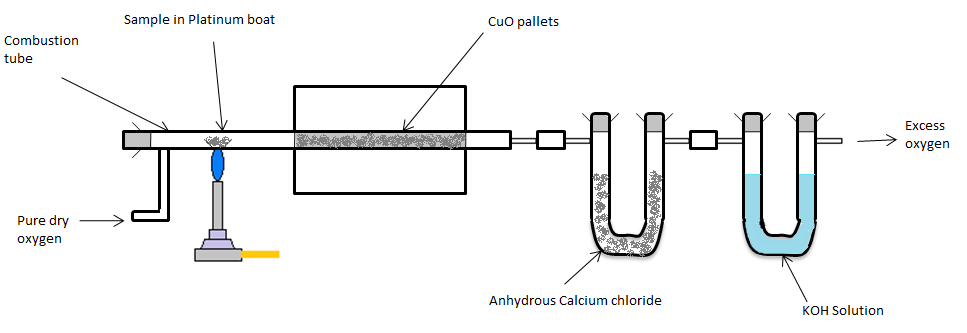
Liebig’s combustion method is used for the quantitative estimation of ____________.
(A) C and H
(B) Halogens
(C) S and P
(D) N
Answer
586.8k+ views
Hint: Try to recall that the principle of Liebig’s is to strongly heat a known mass of organic compounds with excess of dry copper oxide and under these conditions, carbon dioxide and water is produced. Now, by using this you can easily find the correct option from the given ones.
Complete step by step solution:
- In Liebig’s test, a known mass of organic compound is heated strongly with excess of dry copper oxide in presence of pure oxygen and the carbon present is oxidised to carbon dioxide and hydrogen is oxidised to water. The chemical reaction of combustion can be given as under.
\[{{C}_{x}}{{H}_{y}}+(x+\dfrac{y}{4}){{O}_{2}}\to xC{{O}_{2}}+\dfrac{y}{2}{{H}_{2}}O\]
- The combustion products first pass through a U shaped tube containing anhydrous calcium chloride and then, through the caustic potash bottle. Anhydrous calcium chloride absorbs the water content and caustic potash reacts with carbon dioxide gas.
- The carbon dioxide and water formed are collected and weighted.
- The percentage of carbon and hydrogen in the compound is calculated from the mass of carbon dioxide and water produced. The apparatus arrangement for Liebig’s test is shown below.

- Estimation of carbon and hydrogen in an organic compound is based on their conversion to carbon dioxide and water respectively. So, Liebig’s test is suitable for the estimation of carbon and hydrogen present in organic compounds.
Therefore, from above we can conclude that option A is the correct option to the given question.
Note: It should be remembered that under the conditions of combustion, nitrogen if present in the organic compound is also oxidised to oxides of nitrogen which are also absorbed in caustic soda bottles. In such cases, reduced copper gauze is placed near the exit end of the tube which reduces oxides of nitrogen back to nitrogen gas.
Complete step by step solution:
- In Liebig’s test, a known mass of organic compound is heated strongly with excess of dry copper oxide in presence of pure oxygen and the carbon present is oxidised to carbon dioxide and hydrogen is oxidised to water. The chemical reaction of combustion can be given as under.
\[{{C}_{x}}{{H}_{y}}+(x+\dfrac{y}{4}){{O}_{2}}\to xC{{O}_{2}}+\dfrac{y}{2}{{H}_{2}}O\]
- The combustion products first pass through a U shaped tube containing anhydrous calcium chloride and then, through the caustic potash bottle. Anhydrous calcium chloride absorbs the water content and caustic potash reacts with carbon dioxide gas.
- The carbon dioxide and water formed are collected and weighted.
- The percentage of carbon and hydrogen in the compound is calculated from the mass of carbon dioxide and water produced. The apparatus arrangement for Liebig’s test is shown below.

- Estimation of carbon and hydrogen in an organic compound is based on their conversion to carbon dioxide and water respectively. So, Liebig’s test is suitable for the estimation of carbon and hydrogen present in organic compounds.
Therefore, from above we can conclude that option A is the correct option to the given question.
Note: It should be remembered that under the conditions of combustion, nitrogen if present in the organic compound is also oxidised to oxides of nitrogen which are also absorbed in caustic soda bottles. In such cases, reduced copper gauze is placed near the exit end of the tube which reduces oxides of nitrogen back to nitrogen gas.
Recently Updated Pages
The number of solutions in x in 02pi for which sqrt class 12 maths CBSE

Write any two methods of preparation of phenol Give class 12 chemistry CBSE

Differentiate between action potential and resting class 12 biology CBSE

Two plane mirrors arranged at right angles to each class 12 physics CBSE

Which of the following molecules is are chiral A I class 12 chemistry CBSE

Name different types of neurons and give one function class 12 biology CBSE

Trending doubts
Fill the blanks with the suitable prepositions 1 The class 9 english CBSE

Who among the following opened first school for girls class 9 social science CBSE

What does the word meridian mean A New day B Midday class 9 social science CBSE

What is the full form of pH?

Write the 6 fundamental rights of India and explain in detail

Which places in India experience sunrise first and class 9 social science CBSE




